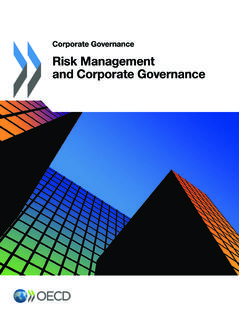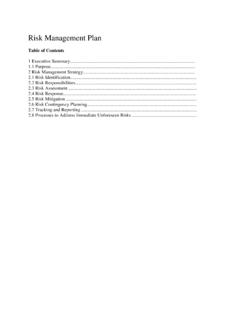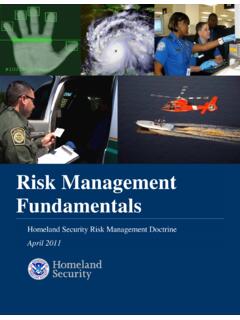Transcription of Management of Risk - Principles and Concepts
1 The Orange BookManagement of Risk - Principles andConceptsOctober 2004 The Orange BookManagement of Risk - Principles andConceptsOctober 2004 Crown copyright 2004 Published with the permission of HM Treasury on behalf of the Controller of Her Majesty s Stationery Office. The text in this document (excluding the Royal Coat of Arms and departmental logos) may be reproduced free of charge in any format or medium providing that it is reproduced accurately and not used in a misleading context. The material must be acknowledged as Crown copyright and the title of the document specified. Any enquiries relating to the copyright in this document should be sent to: The Licensing Division HMSO St Clements House 2-16 Colegate Norwich NR3 1BQ Fax: 01603 723000 E-mail: HM Treasury contacts This document can be accessed from the Treasury Internet site at: For further information on the Treasury and its work, contact: Correspondence and Enquiry Unit HM Treasury 1 Horse Guards Road London SW1A 2HQ Tel: 020 7270 4558 Fax: 020 7270 4861 E-mail: ISBN.
2 1-84532-044-1 October 2004 The Orange Book5 CONTENTS PageForeword Foreword 7 Chapter 1 Overview 9 Chapter 2 The Risk Management Model 13 Chapter 3 Identifying risks 15 Chapter 4 Assessing risks 19 Chapter 5 Risk Appetite 23 Chapter 6 Addressing risks 27 Chapter 7 Reviewing and reporting risks 31 Chapter 8 Communication and learning 35 Chapter 9 The extended enterprise 37 Chapter 10 Risk Environment and context 39 Annex A Example of documenting risk assessment 41 Annex B Overall Assurance on Risk Management 43 Annex C Summary of Horizon Scanning Issues 47 Annex D Glossary of Key Terms 49 October 2004 The Orange Book7In recent years all sectors of the economy have focused on Management of risk as the key to making organisations successful in delivering their objectives whilst protecting the interests of their stakeholders. Risk is uncertainty of outcome, and good risk Management allows an organisation to: have increased confidence in achieving its desired outcomes; effectively constrain threats to acceptable levels; and take informed decisions about exploiting opportunities.
3 Good risk Management also allows stakeholders to have increased confidence in the organisation s corporate governance and ability to deliver. In central government a number of reports, particularly the National Audit Office s 2000 report Supporting innovation managing risk in government departments and the Strategy Unit 2002 report Risk improving government s capacity to handle risk and uncertainty , have driven forward the risk Management agenda and the development of Statements on Internal Control. In 2001 Treasury produced Management of Risk A Strategic Overview which rapidly became known as the Orange Book. That publication provided a basic introduction to the Concepts of risk Management that proved very popular as a resource for developing and implementing risk Management processes in government organisations.
4 This publication is the successor to the 2001 Orange Book . It continues to provide broad based general guidance on the Principles of risk Management , but has been enhanced to reflect the lessons we have all been learning about risk Management through the experience of the last few years. It should be read and used in conjunction with other relevant advice such as the Green Book which contains specific advice on Appraisal and Evaluation in Central Government , the Office of Government Commerce s Management of Risk which provides more detailed guidance on the practical application of the Principles and Concepts contained in this publication, and guidance provided by the Treasury s Risk Support Team as part of The Risk Programme . Wherever possible links and references have been provided to additional resources which explore the Orange Book Concepts in more detail.
5 Perhaps the most significant shift since the publication of the 2001 Orange Book is that all government organisations now have basic risk Management processes in place. This means that the main risk Management challenge does not now lie in the initial identification and analysis of risk and the development of the risk Management process, but rather in the ongoing review and improvement of risk Management . This guidance aims to reflect that for instance, it now includes guidance on issues such as horizon scanning for changes affecting the organisation s risk profile. It also focuses on both internal processes for risk Management and consideration of the organisation s risk Management in relation to the wider environment in which it functions. FOREWORD FOREWORD 8 The Orange Book October 2004 This guidance is intended to be useful to: those who are new to risk Management and those who are tasked with providing training on risk Management in their organisations, both of whom will find it useful as a key introductory document; those who are concerned with the review of risk Management arrangements (such as Audit Committees) as a resource providing a comprehensive statement of Principles against which actual risk Management processes can be evaluated; senior staff whose leadership is vital if an appropriate culture is to be generated in which risk Management can be effective.
6 Operational level staff who manage day to day risks in the delivery of the organisation s objectives and who will find it a practical support in the actual Management of risk; and those who are experienced in risk Management , for whom this guidance explores more difficult Concepts such as risk appetite. It will be equally of use whether the reader s focus of interest is with managing risk at strategic, programme or operational levels. Mary Keegan Managing Director, Government Financial Management Directorate HM Treasury October 2004 October 2004 The Orange It is a matter of definition that organisations exist for a purpose perhaps to deliver a service, or to achieve particular outcomes. In the private sector the primary purpose of an organisation is generally concerned with the enhancement of shareholder value; in the central government sector the purpose is generally concerned with the delivery of service or with the delivery of a beneficial outcome in the public interest.
7 Whatever the purpose of the organisation may be, the delivery of its objectives is surrounded by uncertainty which both poses threats to success and offers opportunity for increasing success. Risk is defined as this uncertainty of outcome, whether positive opportunity or negative threat, of actions and events. The risk has to be assessed in respect of the combination of the likelihood of something happening, and the impact which arises if it does actually happen. Risk Management includes identifying and assessing risks (the inherent risks ) and then responding to them. The resources available for managing risk are finite and so the aim is to achieve an optimum response to risk, prioritised in accordance with an evaluation of the risks . Risk is unavoidable, and every organisation needs to take action to manage risk in a way which it can justify to a level which is tolerable.
8 The amount of risk which is judged to be tolerable and justifiable is the risk appetite . Response, which is initiated within the organisation, to risk is called internal control and may involve one or more of the following: tolerating the risk; treating the risk in an appropriate way to constrain the risk to an acceptable level or actively taking advantage, regarding the uncertainty as an opportunity to gain a benefit; transferring the risk; terminating the activity giving rise to the risk. In any of these cases the issue of opportunity arising from the uncertainty should be considered. The level of risk remaining after internal control has been exercised (the residual risk ) is the exposure in respect of that risk, and should be acceptable and justifiable it should be within the risk appetite. None of this takes place in a vacuum.
9 Every organisation functions within an environment which both influences the risks faced and provides a context within which risk has to be managed. Further, every organisation has partners on which it depends in the delivery of its objectives whether they be simply suppliers of goods which the organisation requires or direct partners in the delivery of objectives. Effective risk Management needs to give full consideration to the context in which the organisation functions and to the risk priorities of partner organisations. 1 OVERVIEW 1 OVERVIEW 10 The Orange Book October The Management of risk at strategic, programme and operational levels needs to be integrated so that the levels of activity support each other. In this way the risk Management strategy of the organisation will be led from the top and embedded in the normal working routines and activities of the organisation.
10 All staff should be aware of the relevance of risk to the achievement of their objectives and training to support staff in risk Management should be available. Hierarchy of risk Source: SU report Risk: improving government s capability to handle risk and uncertainty, Nov 2002 Managers at each level therefore need to be equipped with appropriate skills which will allow them to manage risk effectively and the organisation as a whole needs a means of being assured that risk Management is being implemented in an appropriate way at each level. Every organisation should have a risk Management strategy, designed to achieve the Principles set out in this publication. The application of that strategy should be embedded into the organisation s business systems, including strategy and policy setting processes, to ensure that risk Management is an intrinsic part of the way business is conducted.













